Like most skateboarders, I fell in love with and developed an appreciation for photography from the skate mags of my youth. Throughout the 80s my eyes were constantly scanning the borders of Technicolor photos looking to find the ones credited to guys like Bryce Kanights, Mofo, and J. Grant Brittan.When the 90s rolled around skate photography took a swan dive into a pile of dogshit. Skaters were all about rotating triple flips an inch off the ground and photographers didn't like to point their lenses at anything above the kneecap—the whole situation was painful to look at. But as a result the few guys who were taking a different, more artistic approach emerged from the pack of stock skate photographers and videographers. I was instantly drawn to the work of Thomas Campbell and Daniel Harold Sturt, who tended to shoot wide landscape shots, which showed skateboarding as being a part of its environment rather than the main focus.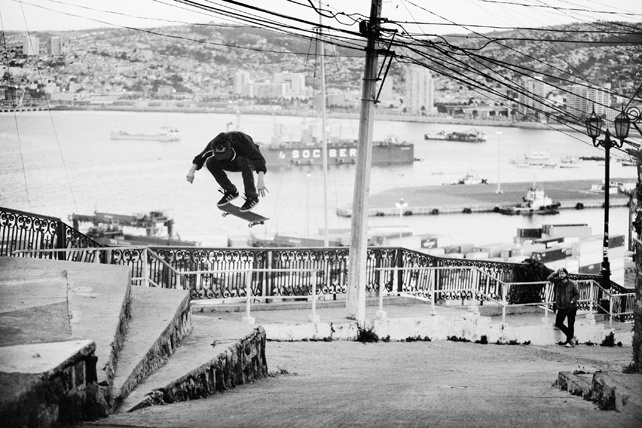 Toward the tail end of the 90s an aspiring photographer from New Haven, Connecticut named Brian Gaberman relocated to San Francisco to work at the now-defunct, legendary skate mag Slap. His aesthetic fell right in line with what I wanted from a skate photo (wide, warm, grainy black and white shots that showcased our world, not a trick) and nothing I didn't (a fish-eye lens jammed up the pee hole of a set of stairs). Over the years his style became more defined. He continued to flex his darkroom skills during the modern age of photoshop, and many moons ago he became pretty much every skater's favorite photographer.
Toward the tail end of the 90s an aspiring photographer from New Haven, Connecticut named Brian Gaberman relocated to San Francisco to work at the now-defunct, legendary skate mag Slap. His aesthetic fell right in line with what I wanted from a skate photo (wide, warm, grainy black and white shots that showcased our world, not a trick) and nothing I didn't (a fish-eye lens jammed up the pee hole of a set of stairs). Over the years his style became more defined. He continued to flex his darkroom skills during the modern age of photoshop, and many moons ago he became pretty much every skater's favorite photographer.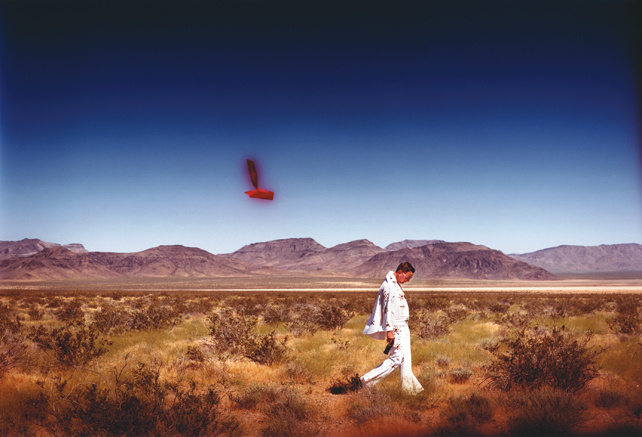 The author, sad and in an Elvis suit.In 2006 Brian became the brand photographer for Element, and for the past seven years he's traveled the globe shooting some of the biggest names in skating—people like Bam Margera, Chad Muska, Nyjah Huston, and a slew of others. I've been lucky enough to travel with Brian a few times and cultivate a friendship with him, so I couldn't be happier about yesterday's release of A Life in Transition, a collection of his favorite photos shot during his tenure with Element. I caught up with Brian to ask him about his book, The Muska, Instagram, and his farm.VICE: How did you get into photography?
The author, sad and in an Elvis suit.In 2006 Brian became the brand photographer for Element, and for the past seven years he's traveled the globe shooting some of the biggest names in skating—people like Bam Margera, Chad Muska, Nyjah Huston, and a slew of others. I've been lucky enough to travel with Brian a few times and cultivate a friendship with him, so I couldn't be happier about yesterday's release of A Life in Transition, a collection of his favorite photos shot during his tenure with Element. I caught up with Brian to ask him about his book, The Muska, Instagram, and his farm.VICE: How did you get into photography?
Brian: I was constantly talking about how much I wanted to become a photographer, but I didn't have a camera. When I was 17 my aunt got tired of hearing about it and bought me a used one that I had to pay her back for. My best friend's father was a photojournalist when we were growing up, so maybe that rubbed off on me a bit.Does being four-feet-tall help you get lower to the ground for those unique angles in your skate photos?
Not as unique as the angle you had on my balls last night. When did you decide that you didn't want to be a stock skate photographer?
When did you decide that you didn't want to be a stock skate photographer?
I did the normal skate photography thing for the first few early years, just trying to imitate what I saw in the magazines, but I was always interested in experimenting. I got bored and disenchanted with it all, took a few years off to focus on personal photography projects, and when I came back to skateboard photography, my approach was a natural extension of the personal work and inherently different than what I had been doing before.Who are some of your favorite skate photographers and why?
Sturt was always a standout for me because of the simplicity of his approach, and Spike [Jonze] and Thomas Campbell for their freedom and experimentation. Mike O'Meally for his beautiful black and white and clarity of vision. [Lance] Dawes and [Gabe] Morford for their work ethic and psychological approach to it, as well as being two guys who took risks and always nailed it.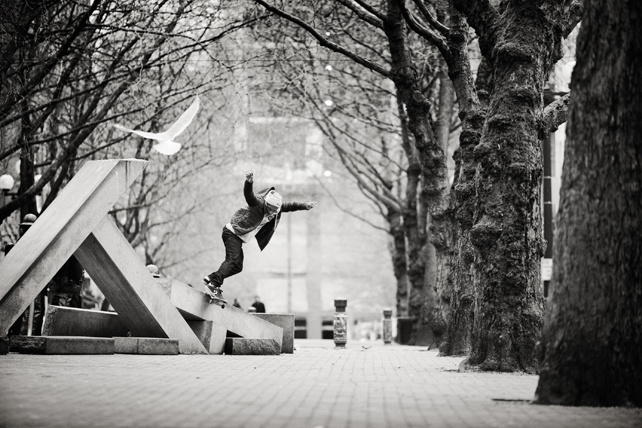 Which photographers outside of skateboarding inspire you?
Which photographers outside of skateboarding inspire you?
Sally Mann changed the way I looked at photography forever. Harry Callahan and Ralph Eugene Meatyard as well. The list could go on forever, but those three all had a profound and lasting impact on how I see things.Tell me about A Life In Transition.
It's a short collection of some of my favorite images made on the road, specifically from the last seven years of working as the brand photographer for Element skateboards. It features most of the team riders from that time period. I really never wanted to make a book, but a few people talked me into it and it was obviously a process I needed to go through. The title relates to the constant state of transition I seem to find myself in. My life at home revolves around farm work, parenting, and trying to feel grounded, while my life on the road is the polar opposite. I always feel like I'm adjusting to where I'm at, and just when I start to get comfortable it's time to go again.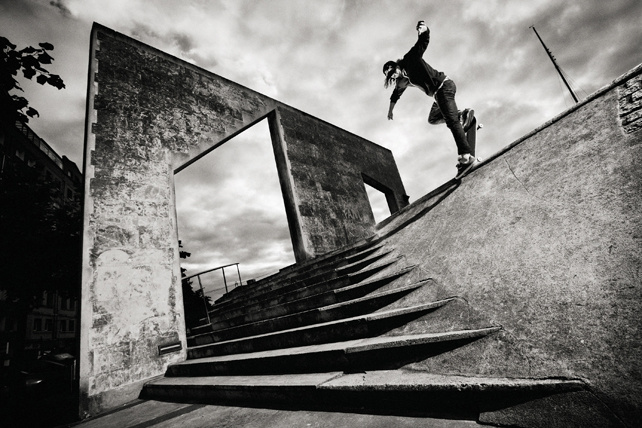 Tell me about the farm you live on. I've heard that you try to live off of what you grow and raise. When did that start?
Tell me about the farm you live on. I've heard that you try to live off of what you grow and raise. When did that start?
Our property is more like a hobby farm. We've got a full solar array; nine Alpacas that my wife raises for fiber; too many egg-laying chickens; a steady stream of meat chickens, ducks, and occasional turkeys; dogs; cats; rats; fish; big gardens; fruit trees everywhere, and on and on… About seven years ago something in me snapped and I just really needed to garden and produce food for my family—maybe some kind of provider instinct or something. As my awareness grows about how fucked our food system is I feel stronger and stronger about doing it. I just don't trust where most food comes from anymore so I figure I should take responsibility for my own.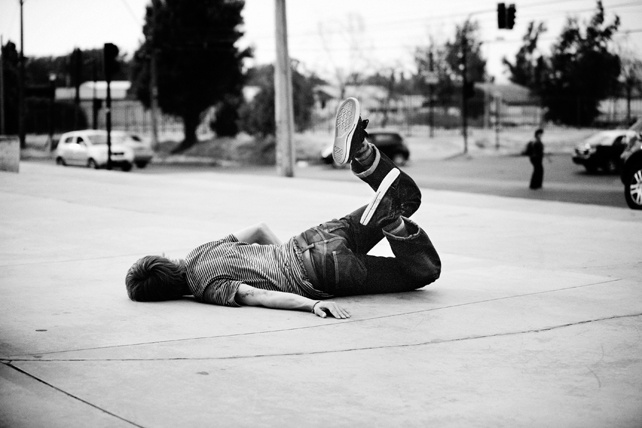 Why no Instagram? With a world of phone-photographers you seem like the only actual photographer who doesn't have an Insta account?
Why no Instagram? With a world of phone-photographers you seem like the only actual photographer who doesn't have an Insta account?
I had an Instagram account for about a month. I vowed that I'd never post a photo though; I just wanted to keep up with my friends' lives since I'm not on any other social media apparatus. I just got bored with it I suppose. Not everything is as special as people seem to think it is and there IS such a thing as too much information. I really don't need to know what your friggin' breakfast looked like today or how good your morning pilates session was. But I suppose we all want to feel special… Element has had quite a colorful and entertaining cast of characters over the years. What's your favorite tour story?
Element has had quite a colorful and entertaining cast of characters over the years. What's your favorite tour story?
Oh boy. I'm really not the storytelling type. I take pictures so I don't have to remember. I'll never forget Muska bushwhacking his way through a Hawaiian rainforest with a machete and his shirt on his head chanting, "Damn dog, I ain't never done no shit like this before," over and over again. He was so gloriously out of place.Ever see Nyjah Cry?
Not that I can recall, but I've definitely seen him take a few slams where I felt like crying for him. He's tough as nails. For more Gaberman go to gaberman.com.Or you can purchase his new book, A Life In Transition, [here](http:// http://us.shop.elementbrand.com/p/mens/accessories/other-accessories/a-life-in-transition-by-brian-gaberman?style=MAMI5AIT&clr=MLT).More stupid can be found at Chrisnieratko.com or @Nieratko
For more Gaberman go to gaberman.com.Or you can purchase his new book, A Life In Transition, [here](http:// http://us.shop.elementbrand.com/p/mens/accessories/other-accessories/a-life-in-transition-by-brian-gaberman?style=MAMI5AIT&clr=MLT).More stupid can be found at Chrisnieratko.com or @Nieratko
Advertisement


Brian: I was constantly talking about how much I wanted to become a photographer, but I didn't have a camera. When I was 17 my aunt got tired of hearing about it and bought me a used one that I had to pay her back for. My best friend's father was a photojournalist when we were growing up, so maybe that rubbed off on me a bit.
Advertisement
Not as unique as the angle you had on my balls last night.

I did the normal skate photography thing for the first few early years, just trying to imitate what I saw in the magazines, but I was always interested in experimenting. I got bored and disenchanted with it all, took a few years off to focus on personal photography projects, and when I came back to skateboard photography, my approach was a natural extension of the personal work and inherently different than what I had been doing before.Who are some of your favorite skate photographers and why?
Sturt was always a standout for me because of the simplicity of his approach, and Spike [Jonze] and Thomas Campbell for their freedom and experimentation. Mike O'Meally for his beautiful black and white and clarity of vision. [Lance] Dawes and [Gabe] Morford for their work ethic and psychological approach to it, as well as being two guys who took risks and always nailed it.

Sally Mann changed the way I looked at photography forever. Harry Callahan and Ralph Eugene Meatyard as well. The list could go on forever, but those three all had a profound and lasting impact on how I see things.Tell me about A Life In Transition.
It's a short collection of some of my favorite images made on the road, specifically from the last seven years of working as the brand photographer for Element skateboards. It features most of the team riders from that time period. I really never wanted to make a book, but a few people talked me into it and it was obviously a process I needed to go through. The title relates to the constant state of transition I seem to find myself in. My life at home revolves around farm work, parenting, and trying to feel grounded, while my life on the road is the polar opposite. I always feel like I'm adjusting to where I'm at, and just when I start to get comfortable it's time to go again.
Advertisement

Our property is more like a hobby farm. We've got a full solar array; nine Alpacas that my wife raises for fiber; too many egg-laying chickens; a steady stream of meat chickens, ducks, and occasional turkeys; dogs; cats; rats; fish; big gardens; fruit trees everywhere, and on and on… About seven years ago something in me snapped and I just really needed to garden and produce food for my family—maybe some kind of provider instinct or something. As my awareness grows about how fucked our food system is I feel stronger and stronger about doing it. I just don't trust where most food comes from anymore so I figure I should take responsibility for my own.

I had an Instagram account for about a month. I vowed that I'd never post a photo though; I just wanted to keep up with my friends' lives since I'm not on any other social media apparatus. I just got bored with it I suppose. Not everything is as special as people seem to think it is and there IS such a thing as too much information. I really don't need to know what your friggin' breakfast looked like today or how good your morning pilates session was. But I suppose we all want to feel special…
Advertisement

Oh boy. I'm really not the storytelling type. I take pictures so I don't have to remember. I'll never forget Muska bushwhacking his way through a Hawaiian rainforest with a machete and his shirt on his head chanting, "Damn dog, I ain't never done no shit like this before," over and over again. He was so gloriously out of place.Ever see Nyjah Cry?
Not that I can recall, but I've definitely seen him take a few slams where I felt like crying for him. He's tough as nails.
